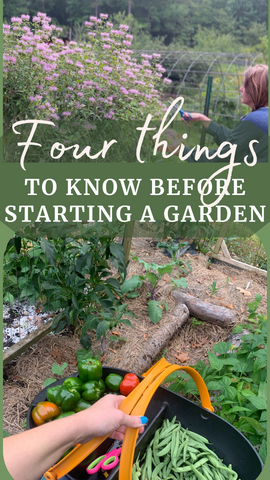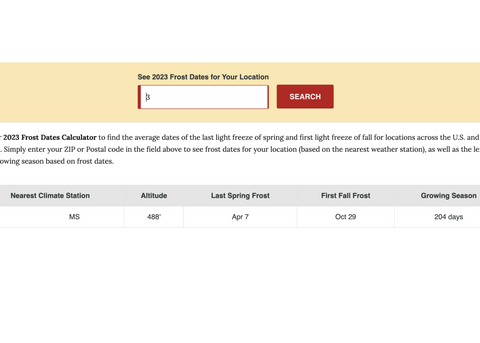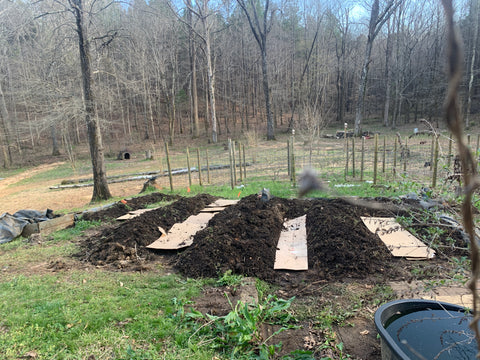4 Things to Know Before Starting A Garden
4 Things to Know Before Starting A Garden
Before starting a garden, there are four essential things to know that apply to a vegetable or a flower garden. I encourage you to mix a little of both for the perfect cottagecore garden!

If you are a beginner, I will cover the basics of what you need to know to be successful. If you have years of experience becoming self-sufficient, it doesn't hurt to get some reminders! You will want to read all the suggestions and then, in the end, start to map out your plan!
While going through the different tips, consider the following:
- What is your overall goal?
- What do you already have in place?
- What will give me the most bang for my buck?
- What do I have time for, and which tip would be too much to handle?
Garden Tip 1: Learn Which Growing Zone You Are In

You can find your growing zone on the USDA website for my fellow community members in the United States here: planthardiness.ars.usda.gov

You will see a zone map like above; find your state, then your geographical area. I am in Zone 7b; therefore, I have average warmer temperatures throughout the year.
You will also see a similar growing zone map on the back of most seed packs. If you buy potted plants, they will also list a growing zone on the tag/pot.

Be careful and research your plant first, though. For example, one year, we almost bought olive trees because they were on sale. When we looked them up, we found they do not grow well in our zone, even though the tag said they would.
Once you get gardening under your belt, you can push your zone a bit warmer by having a greenhouse for plants that like warmer temps.
Garden Tip 2: Know Your Last and First Frost Dates

You can expect the first frost (in the Fall and winter) and the last frost (in the spring). Why do you need to know this?
Well, frost dates help you determine when you can plant. There are so many days after your last frost and so many days before your first frost. You will also see "frost dates" on the back of seed packs.
Frost dates are also easy to find. Go to The Old Farmers Almanac, HERE, and type in your zip code!

It says that my first frost can be on October 29. The USDA hardiness zone tells me it can range from October 29 to November 15. It will change slightly every year, so my dates may vary depending on the year you read this.
Garden Tip 3: Know Your Growing Seasons

This might seem like basic knowledge, but you would be surprised how many people do not understand that vegetables and fruit only grow at certain times of the year.
Grocery stores and restaurants have most of the population believing you can get any fruit or veggie whenever you want. But, the reality is that growing food is seasonal. There are three different growing seasons: Spring, Summer, and Fall.
Make a list of your favorite veggies, some you might want to grow, and look up their growing requirements. This will help you get an idea of when you will have to grow those vegetables.
Some veggies can actually grow in two different seasons, once in early Spring and once in Fall. But, it might take you a little while to comfortable doing this.
Garden Tip 4: Know the BIG THREE: Light, Soil, & Water

I wish I could tell you all you had to do was dig a hole and pop a seed in, and you'd have solved world hunger! But unfortunately, that's not the reality. I can tell you how to start with the proper foundation to be more successful.
For success, you must start with the big three: Light, Soil, and water.
We will go through each and how you can use them in the garden.
Utilizing The Power Of The Sun In Your Garden Layout:
Why is sun so important for a successful garden?
Sunlight = Food
Sunlight is required for photosynthesis. Think back to high school biology. Photosynthesis is the process within a plant that converts light, oxygen, and water into carbohydrates (energy).
Without the energy from photosynthesis, your plants will not have the power to grow, bloom, or produce seeds for the following year's crop.
Without the right amount of sunlight hours needed to produce enough carbohydrates, your plants will use up all their energy reserves and die.

Utilizing the Suns Power:
The sun is the one element you will have the least control over. Sunlight determines what crops you can grow at different times of the year because its position in the sky creates our spring, summer, Fall, and winter seasons.

It can cause your plants to thrive or die. That's why it's essential to utilize all its power in the planning stage of your garden!
Sunlight should be your priority when planning where your garden will go in your yard. You must determine how much sunlight your garden would get if placed in different locations around your home.
Yep, that's right. I said around your home. Don't think your garden must be tucked away behind your house. You can have a garden in your front and side yards, too!
Here is a photo of the start of my herb garden, on the side of the house and on a hillside.

What if gardens surrounded your entire home eventually (realistically, this would be a several-year process)? When you study how the sun interacts around your home, this is a possibility.
Tip:
If you live in a neighborhood with an HOA, restrictive rules might prevent you from adding "veggie" gardens to your front yard. So check before you start.
Some HOA homeowners have successfully sent a well-planned petition to get approval for their front yard gardens.
Moving an Existing Garden:
If you already have an established garden spot started, don't worry. I've been in that same predicament! We created a garden in a location that worked great for the first three years.

We live on the side of a hill, so when a neighbor moved above us, it caused unexpected erosion, and our garden at the bottom began to flood. Add two more years and two seasons of heavy rains, and we had a flooded-out garden.
Tired of battling the water, we moved our garden to our front yard! It was the best decision, and I wish we had done it sooner.




But if you are still getting ready or want to move your current garden location, consider adding a second garden to your perfect sun location.
Finding a Place for Your Garden:
Step 1:
First, you need to walk outside and around your home at three different times: morning, noon, and afternoon.

Take your phone, iPad, or camera with you. Record a video or take photos for reference later. Visual records will give you an idea of what light intensity comes across different spots in your yard during the day.
Tip:
If you are using your phone for photos, create an album labeled "Garden Plan" for quick reference in the future.
In some locations, you might have a well-established tree casting shade on the area in the morning. Your neighbor's house might block the afternoon sun that summer veggies love.

You will want to start your first garden bed in a place where you get the brightest light for the longest. For example, did that spot have 6-8 hrs of sunlight? Once you find the best location, it's time to think from North to South!
Step 2:

At noon, it will fill your garden with light from above, and then the light will hit the left side of the beds in the afternoon. You are allowing even distribution of light throughout the day.
Now that you have established where the sunlight hits your available growing space, it's time to consider bed placements and what kind of garden bed will work for you.
Start Designing
Now for the design part of your garden! Now that you know the location of your garden, your beds need to be oriented North to South, you have a way to access water (Read : ), and you've decided on the type of garden bed (Read: ) ; it's time to get a bit artsy-fartsy!
You DO NOT have to be an artist to sketch out your garden plan. Make it as basic as sketching on notebook paper to using your iPad and apple pen. You can wing it by estimating the spacing or measuring your space and doing a to-scale detailed drawing. It just depends on your personality.
You know I love giving y'all free guides and worksheets, it must be the teacher inside of me! So, here is a PDF printable to help draw out or sketch your garden bed plan! Just click the picture to download:
Tip:
Use a pencil! Don't be surprised if you sketched up your garden several times. That's completely normal and what erasers are made for! You WILL end up changing things around, so play it safe and don't ink it in still everything is done!
The type of garden bed you choose will also determine your soil choices. Soil is so important that it needs its blog. We will discuss this in my next soil blog!
You can also ahead and grab Jan & Feb (both in the Free printable PDF) growing guides they have spaces for planning! Just click the image below:
Thank you for stopping by our modern cottagecore homestead!



